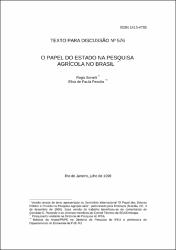Please use this identifier to cite or link to this item:
https://repositorio.ipea.gov.br/handle/11058/2422Full metadata record
| DC Field | Value | Language |
|---|---|---|
| dc.contributor.author | Bonelli, Regis | - |
| dc.contributor.author | Pessôa, Elisa de Paula | - |
| dc.contributor.other | Rezende, Gervásio C. | - |
| dc.coverage.spatial | Brasil | pt_BR |
| dc.coverage.temporal | 1975-1985 | pt_BR |
| dc.date.accessioned | 2014-01-22T15:35:47Z | - |
| dc.date.available | 2014-01-22T15:35:47Z | - |
| dc.date.issued | 1998-07 | - |
| dc.identifier.uri | http://repositorio.ipea.gov.br/handle/11058/2422 | - |
| dc.description.abstract | O investimento em pesquisa agrícola pode ser considerado um investimento como outro qualquer, mas, em geral, caracteriza-se por apresentar retornos muito superiores aos de diversas aplicações alternativas. De fato, taxas de retorno da ordem de 20% a 30% são a norma, e não a exceção, nessa área de atividade. Sugerem que há insuficiência de investimento, isto é, subinvestimento em pesquisa agrícola. Graças, em parte, a isso, os países que se caracterizam por uma agricultura mais atrasada têm dedicado recursos à pesquisa e à extensão agrícola. Sua importância para a elevação da oferta de alimentos em regiões pobres é óbvia, razão pela qual diversas associações internacionais de transferência de tecnologia agrícola foram criadas nas últimas décadas. A ajuda internacional neste caso tem sido bemsucedida e pode ser responsabilizada pelo sucesso na transferência de tecnologia. Mesmo assim, reconhece-se que a tecnologia não é tão facilmente transferível entre países, o que tem historicamente estimulado a criação de centros nacionais de pesquisa em diversas nações. A experiência brasileira nessa área apresenta diversos casos de sucesso. Adicionalmente, não há nenhum sinal de que os recursos gastos em pesquisa, apesar do considerável aumento histórico, tenham implicado diminuição dos retornos à pesquisa. Nossa análise para o Brasil entre 1975 e 1985 é uma modesta contribuição. Ela sugere que as estratégias ótimas de investimento requerem aumentos dos recursos para investimento em pesquisa agrícola. | pt_BR |
| dc.language.iso | pt-BR | pt_BR |
| dc.publisher | Instituto de Pesquisa Econômica Aplicada (Ipea) | pt_BR |
| dc.title | O papel do estado na pesquisa agrícola no Brasil | pt_BR |
| dc.title.alternative | Texto para Discussão (TD) 576: O papel do estado na pesquisa agrícola no Brasil | pt_BR |
| dc.title.alternative | The role of the state in agricultural research in Brazil | en |
| dc.type | Texto para Discussão (TD) | pt_BR |
| dc.rights.holder | Instituto de Pesquisa Econômica Aplicada (Ipea) | pt_BR |
| dc.source.urlsource | http://www.ipea.gov.br | pt_BR |
| dc.location.country | BR | pt_BR |
| dc.description.physical | 40 p. | pt_BR |
| dc.rights.license | É permitida a reprodução deste texto, desde que obrigatoriamente citada a fonte. Reproduções para fins comerciais são rigorosamente proibidas. | pt_BR |
| dc.subject.keyword | Pesquisa agrícola | pt_BR |
| dc.subject.keyword | Intervenção governamental na pesquisa agrícola | pt_BR |
| dc.subject.keyword | Investimento em pesquisa agrícola | pt_BR |
| dc.subject.keyword | Transferência de tecnologia | pt_BR |
| ipea.description.additionalinformation | Referências Bibliográficas: possui referências bibliográficas | pt_BR |
| ipea.description.additionalinformation | Série Monográfica: Texto para Discussão ; 576 | pt_BR |
| ipea.description.additionalinformation | Apêndice: possui apêndices | pt_BR |
| ipea.access.type | Acesso Aberto | pt_BR |
| ipea.rights.type | Licença Padrão Ipea | pt_BR |
| ipea.englishdescription.abstract | Investment in agricultural research can be viewed as any other kind of investment. But, in general, it is characterized by very high rates of return. Actually, rates of return of agricultural R&D on the order of magnitude of 20% to 30% per year are not uncommon. When this is the case, it seems clear that there is underinvestment in agricultural research. It is precisely for this reason that several countries have dedicated increasing amounts of resources to agricultural R&D and extension. In addition to that, the importance of increased resources for agricultural research aiming at increasing the supply of food in poor areas is undisputed. This is the reason why many international agencies have been created to foster the transfer of modern agricultural technologies to these countries. International aid has been well succeeded, in this respect. There is no evidence that resources devoted to agricultural research in Brazil so far have contributed to a decrease of returns, despite the considerable growth that these investments have experienced over the past few decades. Our analysis is aimed at studying this point with the help of cross-section data from the agricultural censuses of 1975 to 1985. The models devised for the purpose of evaluating the magnitudes of returns to agricultural investment in Brazil clearly point to results that confirm the hypothesis stated above: agricultural investments in research by Embrapa have been characterized by very large rates of return in the period analyzed. This suggests that additional resources should be applied in these activities. | pt_BR |
| ipea.researchfields | N/A | pt_BR |
| ipea.classification | Administração Pública. Governo. Estado | pt_BR |
| ipea.classification | Agricultura, Pecuária e Pesca | pt_BR |
| ipea.classification | Ciência. Pesquisa. Metodologia. Análise Estatística | pt_BR |
| Appears in Collections: | Agricultura, Pecuária e Pesca: Livros | |
Files in This Item:
| File | Description | Size | Format | |
|---|---|---|---|---|
| td_0576.pdf | 127.62 kB | Adobe PDF |  View/Open |
Items in DSpace are protected by copyright, with all rights reserved, unless otherwise indicated.

